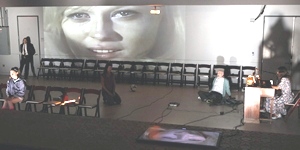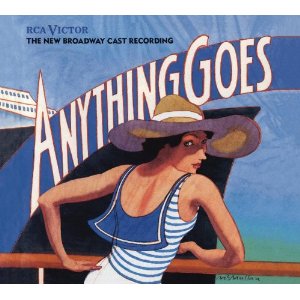SITE GUIDE
SEARCH
REVIEWS
REVIEW ARCHIVES
ADVERTISING AT CURTAINUP
FEATURES
NEWS
Etcetera and
Short Term Listings
LISTINGS
Broadway
Off-Broadway
NYC Restaurants
BOOKS and CDs
OTHER PLACES
Berkshires
London
California
New Jersey
DC
Philadelphia
Elsewhere
QUOTES
TKTS
PLAYWRIGHTS' ALBUMS
LETTERS TO EDITOR
FILM
LINKS
MISCELLANEOUS
Free Updates
Masthead
A CurtainUp Review
House for Sale
By Elyse Sommer
| "I came to feel that the house had been my
mother’s novel, the concrete story she told about herself. . .She pondered the arrangement of paintings on a wall like a writer pondering commas." — Jonathan Franzen's likening his mother's relationship to the house he's preparing for sale after her death is quite touching. This insight notwithstanding, he ultimately rejected her belongings as he had rejected the Midwestern suburban environment of his youth. |

Left to right: Lisa Joyce, Rob Campbell, Christina Rouner, Michael Rudko, Merritt Janson
|
Fish has once again married a writer's exact words to his own concept for making those words suitable for the stage by cutting and pasting for repetitive rhythm, humor or visual interest. As with his his previous piece he uses five actors and a lot of high concept technology to achieve a dramatic aesthetic. Though I'm glad I saw it, I wasn't sold on either the choice of source material for this concept or all of its high tech execution but found it to be an inventive, fascinating failure.
Franzen has earned his stripes as one of our best living novelists by virtue of a daunting vocabulary and his incredible ability to write intricate family sagas as a microcosm of the larger societal picture. The House For Sale essay that is the basis and title for the Transport production, reflects this knack for connecting personal turns in life's journey with turning points facing the society at large. I liked The Corrections enormously. was less enamored of Freedom but admired its complex plot. The essay, while well written, underscores Franzen's unappealingly excessive self-absorption and just doesn't seem to be as worthy of all this inventiveness as t novels like F. Scott Fitzgerald 's The Great Gatsby (Gatz) and Ernest Hemingway The Sun Also Rises (The Select) that have made Elevator Repair Service the go-to innovators of this sort of true to the authors' words literary adaptations.
In fairness to House for Sale, which follows Franzen to his childhood home in Missouri to sell the family house following his mother’s death, it's a situation that's easy to identify with whatever, the state of that home and the memories and feelings stirred by practical considerations and revisiting childhood memories. It can also play out in a brief run time. However, this everydayness makes all Fish's post-modernist cleverness and technical bells and whistles feel a bit gimmicky, a way to make a major literary endeavor out of an essay that's part of a larger work. Not that it lacks some incisive observations, and sseveral quite touching ones. As an example of the latter, there's the way the author-novelist recognizes his mother's relationship with her house as "her novel."
But ultimately this rather tortured diddling with a simple story to make it theatrically intriguing ends up being too often confusing and pretentious. Though only 85 minutes long, House for Sale feels weighed down by the sort of reflective detours that could have been written by Henry James rather than a contemporary, mass audience pleasing writer like Franzen.
Some of the confusion stems from the fact that programs aren't handed out until the end of the performance If you prefer to have that exact figure it out for yourself experience, don't read the next paragraph or the production notes at the end of this review.
It takes some adjustment to have a piece told by a single narrator broken up into text segments for five narrators scattered randomly around a room and having little or no interaction, even when they speak as a chorus. Why intensify that adjustment by forcing the viewer to figure out what the program clarifies — that the constantly changing colored lights are cues to assign which actor is to deliver the text? According to the program, those light cued assignments are live change from performance to performance).
To further keep this piece from coming off like a reading at your local library or a live audio book, the actors do their best with their shared single role. They move around to different seats (there's certainly no shortage of folding chairs in Laura Jellnek's scenic design). They also occasionally lie down, dance and change outfits (Costume designer Terese Wadden saves the best for the very end). Some text is delivered in chorus mode and even sung to music composed by Polly Pen and played mostly by Merrit Janson on a small electronic organ. Other than coming as something of a surprise, Pen's music makes less of an impression than the unusually long incidental music (“Young Americans” by David Bowie) that precedes the actors' first words.
Though the script remains true to the essay's text, Fish's various cut and paste operations make this very different from the original or a nuts and bolts staged reading. While I couldn't quite see the purpose of the video series of "Goofy" segments, the repeated use of a line about a" nine year old beef brisket" turned Franzen's inventory of the contents of his mother's carefully organized freezer into a running joke that went over big with the audience at the performance I attended.
The best of the video illustrations involve Faye Dunaway. During much of the beginning a large photo of Dunaway seems to be watching Franzen's going through the house with a mysterious Mona Lisa smile. When he discovers that his mother made sure that he would find her plate block stamp collection she knew he wanted by placing it in his bed, he recognizes it as a private message from the grave. As Franzen puts it "a complicit wink in her bypassing of Bob (Franzen's older brother). . . it wasn't the intimate look that Faye Dunaway and Warren Beatty exchange in Bonnie and Clyde an instant before they're both shot dead, but it was as close to intimate as my mom and I were going to get." As these words are spoken, a snippet of that movie about these two infamous Midwesterners pops on to the upstage projection screen. Nice touch.
The Transport group mission to explore the work of major American writers has produced a variety of hits in various locations. These included Thornton Wilder's Our Town, William Inge's Requiem for William, Mart Crowley's The Boys in the Band, and composer/writer Michael John LaChiusa's First Lady Suite. In the past several season the company has expanded to mount brand-new works like LaChiusa's Queen of the Mist and Lysistrata Jones, the only misfire for the latter was that it overambitiously interpreted its downtown success as a signal to move it to Broadway.
And so, while House for Sale is more miss than hit, it doesn't miss for lack of theatrical chutzpa.
|
AHouse for Sale Adapted for the stage and directed by Daniel Fish, . from an essay of same name by Jonathan Franzen, Original Music by Polly Pen Cast: Rob Campbell (Orange Light), Lisa Joyce (Red Light), Christina Rouner (Blue Light), Merritt Janson( Green Light) and Michael Rudko (White Light). -- the light colors refer to the assignments wich are cued light and vary from night to night. Scenery: Laura Jellnek Costumes: Terese Wodden Lighting: Thomas Dunn Sound: Daniel Kluger Video Projections: Andrew Lazarow ("Goofy" sections transcribed and altered from various You Tube Videos) Musical director: Katya Stanislavskaya Stage Manager: Noveen Mahmoud Running time: 85 minutes. Transport Group at the Duke on 42nd Street. From 10/13/12; opening 10/24/12; closing 11/18/12 Reviewed by Elyse Sommer at October 21st press preview |
|
REVIEW FEEDBACK Highlight one of the responses below and click "copy" or"CTRL+C"
Paste the highlighted text into the subject line (CTRL+ V): Feel free to add detailed comments in the body of the email. . .also the names and emails of any friends to whom you'd like us to forward a copy of this review. Visit Curtainup's Blog Annex For a feed to reviews and features as they are posted add http://curtainupnewlinks.blogspot.com to your reader Curtainup at Facebook . . . Curtainup at Twitter Subscribe to our FREE email updates: E-mail: esommer@curtainup.comesommer@curtainup.com put SUBSCRIBE CURTAINUP EMAIL UPDATE in the subject line and your full name and email address in the body of the message. If you can spare a minute, tell us how you came to CurtainUp and from what part of the country. |

Slings & Arrows- view 1st episode free
 Anything Goes Cast Recording
Anything Goes Cast RecordingOur review of the show
 Book of Mormon -CD
Book of Mormon -CDOur review of the show

